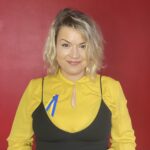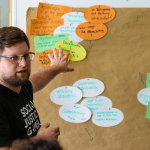Image is illustrative. Dariusz Sankowski (Pixabay)
What is library literacy?
Libraries are a source of infinite wisdom for those who know how to make the most of them and a source of headache for the student that wants to do quick research for an essay due the next morning. To be library literate, one must:
- Understand the function, availability and use of different resources.
- Be able to select relevant information from a myriad of options.
- Know how information is organised, how to take bibliographic instruction and how to utilise user manuals.
- Through the competences mentioned above, be familiar with information-seeking processes within their own community, abroad as well as online. (Coravu, 2010; Greer, Weston & Alm 1991; Rader, 2019)
Therefore, library literacy covers more than just being able to orientate through the vast amount of knowledge in a physical or online library – it helps create fact-based dialogue. For example, say you find a post on Facebook on the latest trendy apps and want to post about it on the social media of your youth organisation.
How to be library literate?
One could just take the arguments in text at face value and just share the original post, but someone who is library literate will:
- First check the arguments made in the article by looking for other resources on the same topic
- Add new sources they found when checking the first one
- Compare the data
- Critically analyse the text before publishing it
- Reference all the sources used in the text.
Following these steps helps avoid reproducing factually-incorrect information online.
Avoiding plagiarism
Understanding the availability and use of different resources means that one must know how and when to cite the sources used in order to avoid plagiarism – presenting someone else’s thoughts as your own. Did you know there are different types of plagiarism?
Accidental plagiarism might happen if one does not have knowledge on how to properly reference, paraphrase and quote, but unintentional plagiarism is still treated as seriously as all other types (Bowdoin, 2019; Walker, 1998). So, for example, if you remember an idea and paraphrase it but can’t remember the source and therefore do not attribute credit where credit is due, you have stolen someone’s idea and can be held accountable regardless. Mind you, attribution by citing might not be enough in all cases, as some material might also require a copyright release (Alam, Ratner, Coleman III, 2019).
Mosaic plagiarism or patchwriting refers to a situation in which one has used another source, but instead of attribution, has found synonyms or paraphrased parts of it – this can have the element of a lack of knowledge and can also be intentional (Bowdoin, 2019; Walker, 1998). Self-plagiarism, however, is a deliberate form of student plagiarism and occurs when students recycle previous assignments or submit previous work without the knowledge of the professor or lecturer (Bowdoin, 2019; Walker, 1998). For example, you may have written a brilliant essay in high school and decide to re-use it at university, but if there is an element of deceiving the recipient of the assignment into thinking the material is new and original, you have self-plagiarised.
And, of course, there is direct plagiarism, which is an exact copy of someone else’s work without using quotation marks or citations (Alam, Ratner, Coleman III, 2019; Bowdoin, 2019). It could be deliberate, but can also be accidental, like when you find a really great quote whilst researching, but forget to add the citation, or when you find something great in your notes and mistake it for you own thoughts, when really you heard it from someone else and forgot to make a note of the author (Bowdoin, 2019).
Knowing how to and when to refer is therefore key in avoiding plagiarism. Of course, text, video or photos online are re-published over and over so many times you might not even find the original author, but search engines can be of immense help with this.
Tips for ethical sourcing:
- “The internet” is not a source – online materials in different formats must be cited too (Plagiat.pl, 2018).
- Unpublished work is also under copyright and needs to be referenced (Plagiat.pl, 2018).
- When trying to decide whether or not you might have accidentally committed intellectual theft, ask yourself: am I the first person to think of this? If in doubt, double check in search engines and online databases.
- With text, copying a sentence of the text in a search engine and putting in quotation marks will land you results, where the sentence in that exact order has been used. It is one of the commands of Boolean searching, and this lands you more exact results.
- Reverse image search on Google lets you upload a photo in order to reveal all the sources that have published it, which usually leads to the original source – this is especially useful in attributing authorship with memes.
- Evaluate content online as you would with written materials – start with this handy guide.
- Learn citation rules. There are guides online for all citation styles, such as MLA, APA, Chicago, Harvard, etc. When using Google Scholar, you can click on an image of a quotation mark under each result and it will generate the correct full citation in whichever style you prefer.
- When in doubt, add a reference. Better to reference too much than not enough (Plagiat.pl, 2018).






